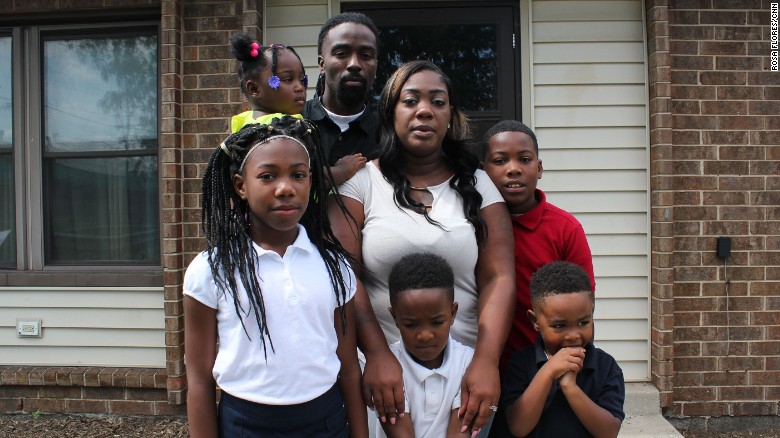‘How dare you … let our kids play in lead and arsenic soil’
At this point we understand the dangers of lead poisoning and yet, the government continues to be very slow acting to rid our pipes of this invisible poison.
This is Shantel Allen’s story.
The 27-year-old mother of five lives in the West Calumet Complex in East Chicago, Indiana, and has for about six years. Her trouble this summer when a Department of Health official knocked on her door and announced that her family needed to be tested for lead poisoning. But it wasn’t from her pipes, it was coming from her yard.
From the article:
“In a letter from the EPA dated July 11, 2016, she was informed that some parts of her yard had lead levels up to 66 times above the lead limit and 55 times above the arsenic limit set by the Environmental Protection Agency. But what shocked her even more was that the letter said her “property was tested for lead and arsenic at the end of 2014.” Which means the test was somewhere in a lab, on a shelf, on a desk or getting processed for more than a year and a half before she learned of the danger she and her children were in.”
And things only got worse from there; she received a letter from the Indiana State Department of Health saying that her 2-year-old daughter, had a lead result of “33 capillary.” The CDC’s upper level of concern is 5.
At the time of testing, 1-year-old Samira wasn’t old enough to play in the dirt and yet her levels were THAT high. This left Shantel understandably worried about her other kids who had been playing in the yard for years.
More from the article:
“Allen’s 9-year-old son was recently diagnosed with hyperactivity disorder, she says. And her other children, ranging in age from 4 to 8, have also displayed symptoms that she says she couldn’t explain before. “They show all the signs and symptoms of having lead poisoning. They have fevers, chills; they vomit. … I’ve taken them to the emergency room a number of times,” Allen said.
The West Calumet affordable housing complex is within the US Smelter and Lead Refinery Inc. Superfund site, according to the EPA.
A Superfund site is an area that has been contaminated by a dangerous substance and the EPA has determined that it poses health and environmental risks. The West Calumet Complex was built on top of the Anaconda White Lead company, according to EPA records. It is also south of the former USS Lead industrial site and next to a DuPont site. Together, these companies smelted, dealt with or processed lead for decades.”
And do you think anyone told her or anyone else living there? No, of course they didn’t. However, what they are telling them now is they have to move. The Allen family and about 1,000 of their neighbors.
The EPA has found that the most contaminated yards showed lead levels 227 times above the lead limit and 135 times above the arsenic limit set by the EPA. But the more pressing issue is that they’ve known about this since 2009, when it was added to the National Priorities list, which has been described (in a 2012 transcript of a public meeting) as the “EPA’s nationwide list of the most contaminated sites in the country.” It was that bad and NO ONE said a thing. NOTHING.
Allen is suing. And she’s not alone (good for her).
Even though the EPA has signs posted outside homes reading, “Do not play in the dirt or around the mulch,” kids are still playing ON the soil. Not that it matters; home interiors were tested July 25th and elevated lead levels were found there as well.
Allen said, “I kind of panicked, because it’s like we’re just sleeping in it. And lead — we’re sitting on contaminated furniture; our kids are walking barefoot on these contaminated floors.”
But, who is to blame?
- The East Chicago mayor blames the EPA’s Region 5 because in December of 2014, Region 5 got soil sampling data showing the lead contamination within the West Calumet Housing Complex (info they wouldn’t share with the city until May 24, 2016).
- The EPA responded, “In retrospect, with spikes in the preliminary data, we realize that with increased scrutiny of that initial data it could have triggered action to be taken sooner, instead of having to wait until the data was fully assessed. EPA will institute a process to review preliminary data to flag the need for immediate action.”
But what about the Indiana State Department of Health? Why did the Allen family only receive their daughter’s high blood lead level result last month?
- The ISDH maintains that “it is the responsibility of the local health department to convey test results to patients and follow-up with them. Direct communications of blood lead results with patients by the Indiana State Department of Health are outside the standard process but, if made, are intended only to supplement the work of local health departments.”
- And the City of East Chicago lays the blame with the State because they withdrew funding for blood lead testing in 2011 which led to cuts to local programs. The city claims they were checking the state database for excessive blood lead results, but the state wasn’t updating the database.
- ISDH disputed those claims.
The US Department of Housing and Urban Development has given those living in the danger zone $1.9 million for rent vouchers and $400,000 for relocation specialists to help everyone move to a safe neighborhood. However, the for some, the damage may be irreversible.
Allen has something to say about what she and her family have been through:
“Shame on you. We’re people. We’re human people with families,” Allen said. “How dare you keep this from us and just let our kids play in lead and arsenic soil? How dare you? Shame on you.”
Agreed.
Shame, shame, shame.
Source: CNN












